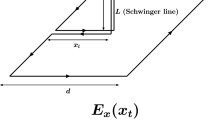Abstract
We calculate the effect of radial confinement on the Schwinger pair production rate by solving the Dirac equation in a flux-tube cylinder containing a constant chromoelectric field in the longitudinal direction. We show how the Dirac equation separates into radial and longitudinal equations for a mass term which has an arbitrary radial dependence and introduce radial confinement by having a finite mass inside the cylinder and an infinitely large mass outside. The resulting boundary conditions are equivalent to the MIT boundary condition. The equations are solved analytically for a constant quark mass inside the flux-tube, which acts like a waveguide. The discretization of the transverse wave vector which has a continuous spectrum in the non-confined case leads to a large suppression of the Schwinger pair-production rate for small radii. The minimal radius where pairs are created decreases with increasing field strength. The suppression turns out to be larger for heavier quarks than for light quarks.
Similar content being viewed by others
References
J. Schwinger: Phys. Rev. 82 (1951) 664
M. Soffel, B. Mueller, Greiner, W.: Phys. Rep. 85 (1982) 51; W. Greiner, B. Mueller, J. Rafelski: In: Quantum electrodynamics of strong fields Berlin, Heidelberg, New York: Springer 1985
E. Brezin, C. Itzykson: Phys. Rev. D2 (1970) 1191
H. Neuberger: Phys. Rev. D20 (1979) 2936; C.B. Chiu, S. Nissinov: Phys. Rev. D20 (1979) 945
H.G. Dosch, D. Gromes: Phys. Rev. D33 (1986) 1378
P.H. Cox, Yidiz: Phys. Rev. D 32 (1985) 819
A. Casher, H. Neuberger, S. Nussinov: Phys. Rev. D20 (1979) 179
N.K. Glendenning, T. Matsui: Phys. Rev. D28 (1983) 2890
F.E. Low: Phys. Rev. D12 (1975) 163
F.E. Low: Phys. Rev. Lett. 34 (1975) 1286
T.S. Biro, H.B. Nielson, J. Knoll: Nucl. Phys. B245 (1984) 449
R.-C. Wang, C.-Y. Wong: Phys. Rev. D38 (1988) 348
C. Martin, D. Vautherin: Phys. Rev. D38 (1988) 3593; C. Martin, D. Vautherin: Phys. Rev. D40 (1989) 1667
Th. Schoenfeld et al.: Phys. Lett. B247 (1990) 5
T. Damour: In: Proceedings of the first Marcel Grossmann meeting on general relativity, edited by Ruffini, p. 459, Amsterdam: North Holland 1977
J.D. Bjorken, S.D. Drell: Relativistic quantum mechanics, New York: McGraw-Hill 1965
A. Chodos, R.L. Jaffe, C.B. Thorn, V. Weiskopf: Phys. Rev. D9 (1974) 3471; A. Chodos, R.L. Jaffe, K. Johnson, C.B. Thorn: Phys. Rev. D10 (1974) 2599
M. Abramowitz, I. Stegun: Handbook of mathematical functions, New York: Dover 1965
Author information
Authors and Affiliations
Rights and permissions
About this article
Cite this article
Pavel, H.P., Brink, D.M. \(q\bar q\) pair creation in a flux tube with confinement. Z. Phys. C - Particles and Fields 51, 119–125 (1991). https://doi.org/10.1007/BF01579568
Received:
Revised:
Issue Date:
DOI: https://doi.org/10.1007/BF01579568




